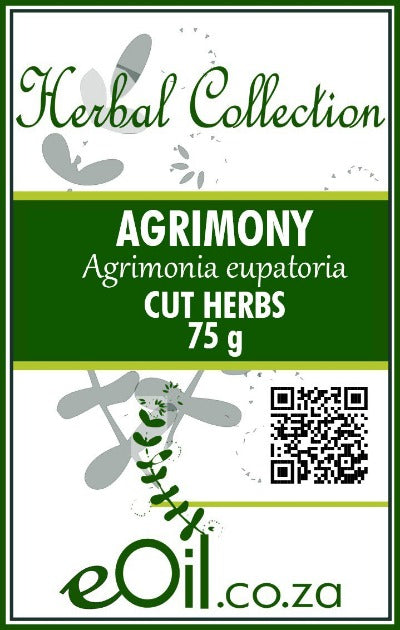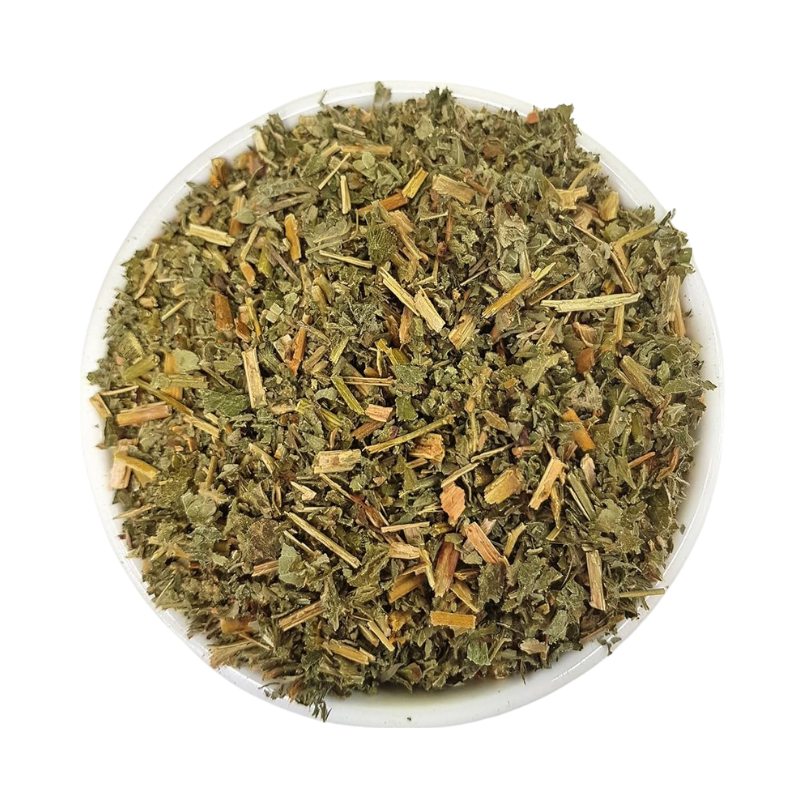Agrimony Herb Cut - Herbal Collection
Agrimony Herb Cut - Herbal Collection - 75 GR is backordered and will ship as soon as it is back in stock.
Description
Description
Agrimony Herb Cut ( Agrimonia eupatoria ) is a traditional botanical valued for its earthy aroma and subtly astringent character.
Commonly used in teas, infusions, and homemade body care blends, its dried leaves and stems bring gentle, natural flavor to culinary and herbal routines.
Pure, naturally dried, and additive-free
IDENTIFICATION
Scientific Name: Agrimonia eupatoria L.
Family: Rosaceae (rose family)
Common Names: Common agrimony, Church steeples, Cocklebur, Sticklewort
Parts Used: Aerial parts (leaves, stems, flowers)
Origin: Native to Europe, naturalized in North America
CAS Number: 84775-40-6 (for Agrimonia eupatoria extract)
Appearance: Perennial herb with pinnate leaves and small yellow flowers in long spikes
Odor: Slightly aromatic, spicy scent like apricots when dried
Storage: Store dried herb in airtight containers in a cool, dark place
Description
Agrimony is a perennial herb native to Europe and parts of Asia. When dried and cut, it consists of the aerial parts of the plant, including leaves and stems.
The leaves are dark green with numerous soft hairs, and when dried, they maintain their characteristic serrated edges.
Chemical Composition
The main active compounds in dried Agrimony include:
- Tannins (3-11%), including proanthocyanidins and ellagitannins
- Flavonoids (about 0.9%), including quercetin, luteolin, apigenin, kaempferol
- Triterpenoids (ursolic acid, euscapic acid)
- Phenolic acids
- Polysaccharides (19.5%)
- Minerals (7.3-7.9%)
TRADITIONALLY USED FOR
Agrimony Herb Cut (Agrimonia eupatoria)
Agrimony Herb Cut is a traditional herbal product made from the dried aerial parts of Agrimonia eupatoria, a perennial plant native to Europe and parts of Asia. Renowned for its gentle, astringent properties and slightly bitter taste, this herb has been valued for centuries in natural wellness and home remedy traditions.
With its serrated, dark green leaves and subtle, earthy aroma, Agrimony is commonly prepared as a herbal infusion or tea and is sometimes used as a gargle or wash for mucosal and skin care support. The presence of flavonoids and tannins gives this herb its distinctive effects and character.
Traditional Uses
- Astringent for mild diarrhea and digestive support
- Assists in soothing sore throats (as a tea or gargle)
- Traditional use for urinary and liver health
- Externally used as a wash for minor skin irritations and wounds
Preparation
- For herbal tea: Steep 3–12g of dried herb in boiling water for 10–15 minutes. Strain and enjoy up to three times daily.
- Can be used as a mouthwash for oral or throat care.
Precautions
- Use as directed by a qualified herbalist
- Not recommended during pregnancy or breastfeeding
- May increase sensitivity to sunlight due to high tannin content
- Always consult a healthcare professional if using alongside other medications or health conditions
This product is based on traditional use. Not intended to diagnose, treat, cure, or prevent any disease. Please consult a healthcare professional before using herbal products, especially if pregnant, nursing, or on medication
INFORMATION
Preparation and Dosage
For herbal tea (infusion):
- Use 3-12g of dried herb per cup of boiling water
- Steep for 15 minutes
- Strain and drink up to 3 times daily
For children:
- Ages 1-4: 1-2g daily
- Ages 4-10: 2-3g daily
- Ages 10-16: 3-6g daily
Properties and Uses
Dried Agrimony herb is known for its:
- Astringent properties
- Mild diuretic effects
- Anti-inflammatory action
- Antioxidant activity
Common medicinal uses include:
- Mild diarrhea in adults and children
- Urinary incontinence
- Digestive issues (IBS, upset stomach)
- Sore throat (as a gargle)
- Mild skin inflammations (as a wash)
- Liver and gallbladder support
Precautions and Side Effects
- Generally considered safe when used in recommended doses
- Large amounts may cause stomach irritation due to high tannin content
- May increase sensitivity to sunlight
- Avoid during pregnancy and breastfeeding
- May interact with diabetes medications
Storage
Store dried Agrimony in an airtight container in a cool, dark place away from direct sunlight. When properly stored, dried herbs generally have a shelf life of 1-2 years.
Conclusion
Dried Agrimony herb cut is a versatile herbal remedy with a range of traditional and potential medicinal uses.
Its astringent and anti-inflammatory properties make it particularly useful for digestive and urinary tract issues.
However, as with any herbal remedy, it should be used under the guidance of a qualified healthcare practitioner, especially when combined with other medications or for long-term use.
CAUTION
Store in a cool, dry place, away from light. Keep tightly closed, away from the reach of Children and pets.
Do not exceed the daily dose.
This product is not intended to prevent or cure any form of illness or disease.
If you are pregnant or nursing ; If you have a medical condition or are in the course of medical treatment ; If you are programmed for theater/operation in the near future, please consult your healthcare practitioner before using this product.
This product cannot replace a varied and balanced diet and a healthy lifestyle.
This product has not been evaluated by the SAHPRA for its quality, safety or intended use.
For More Information please check our General Safety Herbal products Page

Agrimony Herb Cut - Herbal Collection - 75 GR is backordered and will ship as soon as it is back in stock.






